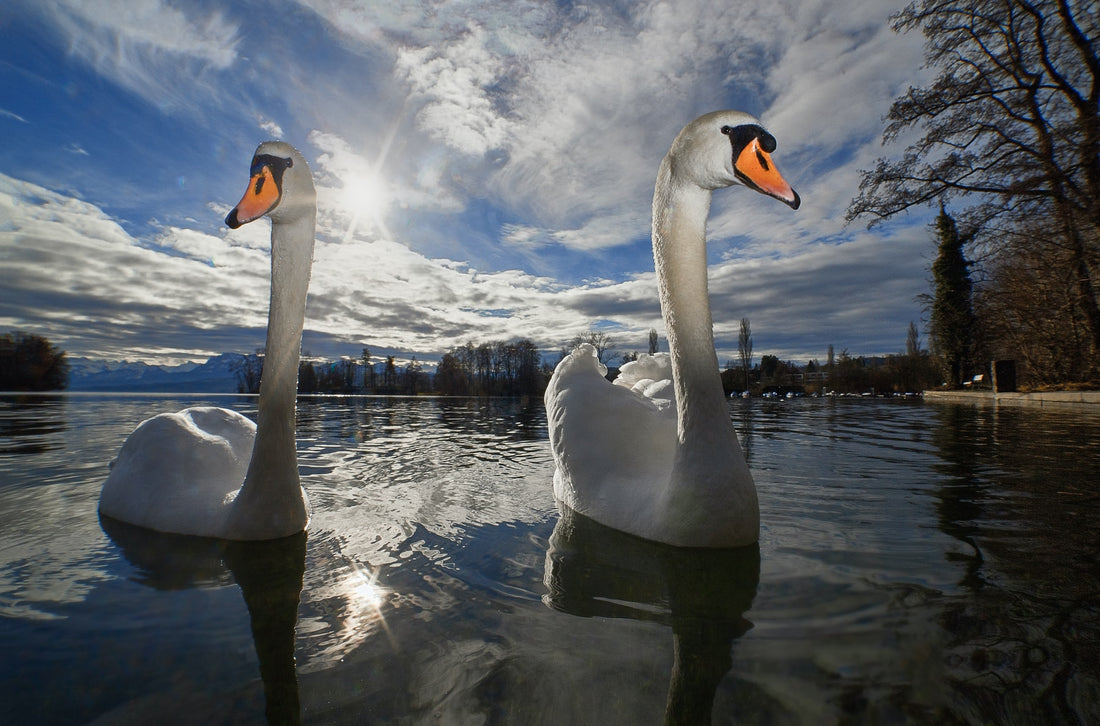Elegant. Beautiful. Confident. Three words that spring to mind when you think of sans. Their beautiful long necks and silent gliding over the water's surface bring a smile to everyone who sees them. These majestic creatures are often misunderstood and are the epitome of beauty on lakes and rivers. Understanding swans and their cygnets help us provide a better environment for them in the wild, so let's learn more about swans!
What Do Swans Eat?
Mostly, swans are herbivores. This means that plant matter and grains are their primary sources of food. Some swans eat water beetles and pond skaters, but it's rare. Cygnet swans, in their first couple of weeks of life, consume some animal matter, but it's not enough to matter much! The more they grow, the less animal matter they'll eat. Most of the time, animal matter consumption by female swans and male swans are eaten by accident. When food is sprinkled in the water, they eat tadpoles, worms, frogs’ eggs, and fish as they scoop it up. These items are also commonly stuck in weeds that swans will eat. Freshwater mussels are also called the "swan mussel, " and this is a misnomer. Swans don't go out of their way to consume freshwater mussels, and if they do, it's not on purpose.
Swans only drink water and lots of it! They are designed for swimming and living in freshwater, and so they drink it as much as possible. Mute swans also drink freshwater over saltwater, even though swans CAN drink saltwater. There are glands located near the eyes, just below the skin that extracts salt from the bloodstream, which is exceptionally intelligent if there is no fresh water available. The salt goes out through the nares, which are the holes in the bill of the swan.
Mute Swans prefer to eat and drink while they float on the water, as it takes a lot of energy to paddle and swim - more than walking on land.
Energy conservation is vital for the survival of swans, as birds are warm-blooded and have to burn many calories to remain at the right temperature. Any wasted energy by walking to find food means more food needs to be consumed to stay healthy. Swans love green plants over any other kind, but the issue is that raw plants and vegetation are harder to digest due to the higher levels of cellulose.
Do Swans Have Teeth?
Swan teeth are a little bit of a myth! Many people think that swans have teeth, but what they do have is a gizzard. This grinds the food into a pulp, which increases the surface area of the food, making it more likely to be digested.
Types of Swans
Swans are recognisable for their very long necks and their silent movement across bodies of water. Swans are the largest of all of the waterbirds out there, and three different species are identifiable in the UK. The Mute Swan is the largest and is resident all year round, and the other two - the Bewick’s Swan and the Whooper Swan goes on a very long migration from their usual breeding ground in the Arctic to the UK shores.
Bewick's Swan
Every year, Bewick’s swans fly thousands of miles away from its breeding ground in the far north to the UK. Not all of these swans make the journey, and the numbers have lowered considerably over the years. Wetland habitats are being lost, and people shoot them down during their migration. From bill to tail, Bewick’s swans are 115-127cm long. They have a wingspan wider than this, between 170-195cm wide, and they weigh around 6kg.
It’s the smallest swan, not much bigger than a Canadian goose. The adults have white feathers, and their bills are black and yellow. Cygnet swans are grey and white, with a pink bill. These are easily mistaken for the Whooper swan, as both migrate in the winter. Whooper swans are more significant than the Bewick’s swans and have a honking voice.
Bewick’s swans live in coastal bays, farmland, and freshwater wetlands through the winter. In the summer, they reside in the Arctic. Bewick’s swans eat field grass, potatoes, sugar beets, wheat, and grains in the UK. In the Arctic, they eat aquatic plants and berries.
Whooper Swan
Compared to the Bewick’s Swan, Whooper swans take the longest sea-crossing between Iceland and the UK. They fly at exceptionally high altitudes, and they are more significant than other swan breeds. They are 140-160cm from bill to tail, with a large wingspan of 205-235cm, weighing in between 9-11kg. Whooper swans have a black bill, and there is a triangular patch of yellow on the top. They have white feathers and a long, thin neck. As with the Bewick’s swan, the Whooper swan lives in wetlands, coastal bats, and farmland.
Black Swans
Originally from Australia and New Zealand, black swans are seen across the world. They are recognised by their black feathers and bright red bill. Their necks are longer than any other swan breed out there, making them some of the most graceful creatures on water. They have a high-pitched bugle, and they can whistle, which is often heard when they are disturbed from their nests. They nest in the year's wetter times, and they can nest as individuals or in colonies. Their nests are large, usually in shallow water or on islands in large lakes and rivers. They have 4-8 eggs in breeding months, and these take up to 40 days to hatch.
Swan Facts
Swans are fascinating creatures, and there are tons of fats that will teach you all about them - including the ones that we have listed for you below:
- Swans are close relatives to geese and ducks.
- You will mostly find swans gliding on the lakes and water out there, representing refinement and elegance - even royalty own swans!
- Swans are the biggest members of the waterfowl family.
- Swans are some of the largest flying birds around.
- There are swans around the world, with some in North America living for an average of 24 years. Some have been known to live for 33 years! Mute swans live for around 20 years on average, and black swans can live up to 40 years in the wild.
- Swans can be found in the northern hemisphere and the southern hemisphere. Northern swans are distinguishable by their white colouring and orange beak, where southern wans are usually white and black with red or black beaks.
- You can find swans in rivers, streams, wetlands, lakes and grassland that have been flooded.
- Swans can rarely be found in the tropics, as they prefer to have a more temperate environment to live in.
- Feeding primarily on aquatic vegetation, swans are herbivores. Their long necks allow them to feed on river plants and they can eat little animals that cling to the vegetation. They will also eat grass and graze in fields if it’s available.
- Mute swans are partial migrants while being resident in areas of Western Europe and are wholly migratory in the Asian countries and in Eastern Europe. Whooper, Tundra and Trumpeter swans are fully migratory.
- Swan calls are very obvious when you hear them. They hiss when their nests are threatened, and they have trumpet-like honking sounds that help them to call to other swans. They even peep and gurgle to each other.
- Swans are known for mating for life. It’s rare, but a “divorce” occurs if there is a nesting failure or a mate dies. Remaining swans will then take up with another swan, allowing them to try again elsewhere. Bonded swans live in pairs year-round, but they will be social with other swans outside of the breeding season. Pairs work together to aggressively protect their nests while swans are breeding.
- Nests are built on land from twigs, leaves and collected feathers and moss. Female swans will lay up to 9 eggs while they are breeding. Baby cygnets will hatch after a month. Cygnet are guarded by their parents away from all predators and animals that they believe could be a threat - including humans. Swans will hiss and charge at anything threatening their cygnets, and after they manage to scare off a threat, swans will celebrate!
- Male swans are called cobs, and female swans are called pens. Baby swans are cygnets, and a group of swans are known as a bevy, or a wedge.
- Juvenile swans will remain a part of a flock until age 4. They will be considered an adult after that, and they will then seek a mate. Usually, they mate with those in the same flock, and then leave the flock with their mate to create their own territory.
Swans are beautiful, fascinating creatures and they remain some of the most beautiful creatures on water. Too many reports come in of people destroying their nests on the sides of lakes and rivers, and we should be protecting swans as much as possible. Swans stick together, and they will hunt and raise their babies together. It’s wonderful to see!

